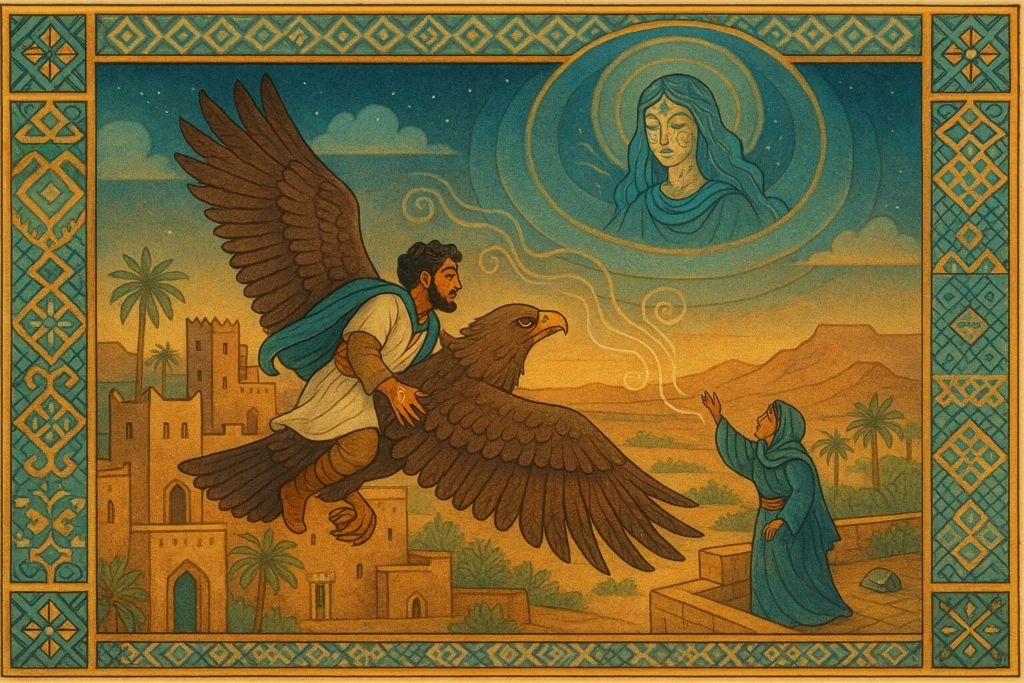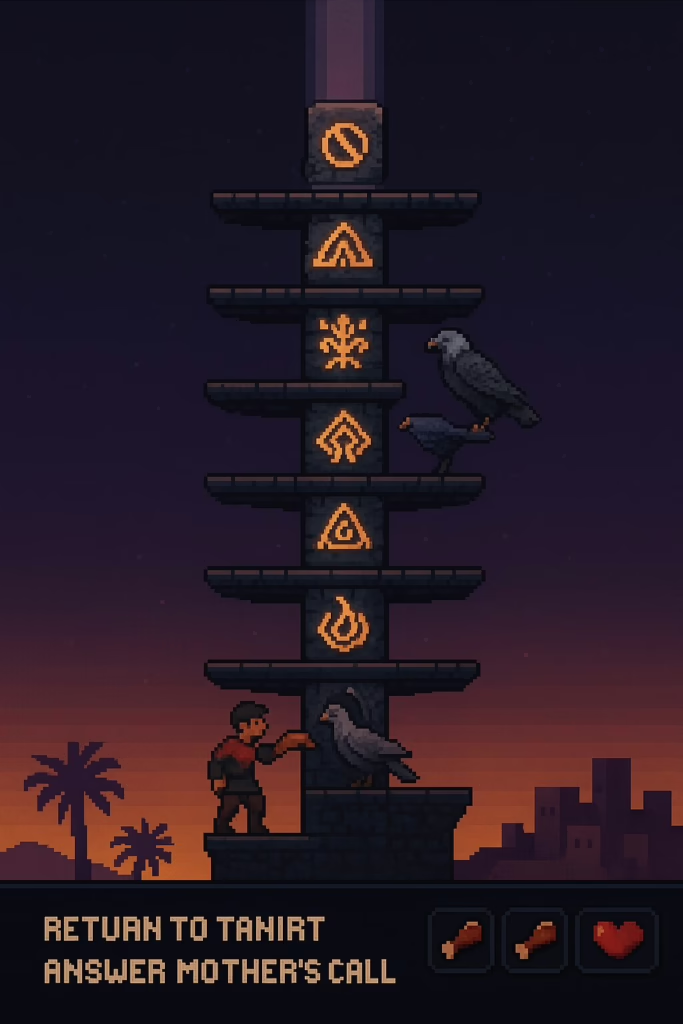The Ounamir myth, a cornerstone of Amazigh oral tradition from southern Morocco, tells of Hemmou Ounamir, who marries a sky-being, breaks a taboo, and falls from the seventh sky while answering his mother’s cry. The tale explains origins, encodes social values, and mirrors global mythic patterns like Orpheus.

What is the Ounamir myth?
In the most attested versions, Hemmou Ounamir is a gifted student whose beauty attracts Tanirt (often translated as an angel or fairy). She secretly marks his hand with henna. Exposed at the Quranic school, Ounamir captures Tanirt with his teacher’s ruse. She agrees to marry him if he builds an unbreachable home, but his mother discovers the hidden key and violates the forbidden space. Tanirt returns to the heavens. Ounamir wanders for years, then feeds an eagle with seven meat portions, the last replaced by his own flesh, and rides it to the seventh sky to rejoin her. He must obey one condition, never lift a certain stone. On the Feast of Sacrifice, he lifts it, glimpses his grieving mother on earth, and leaps down. In some tellings, drops of his blood restore his mother’s sight or complete the sacrifice.
Outside the text, cultural memory localizes the story around Tata and Tagoujgalt in southeast Morocco, where people point to a vanished handprint in rock and a namesake cascade. Some narrations claim his “five fingers” became springs across tribes. These place-marks help explain why locals often treat the story as historical.
Modern summaries by Moroccan outlets align with these motifs, noting the eagle guide, the seven portions, and the seventh sky. MapNews+1
Why scholars call it a “myth,” not just a folktale
Across versions, Ounamir functions as a founding narrative: it explains beginnings, authorizes customs, and maps sacred boundaries, which are classic markers of myth. Theoretical lenses from Eliade and Durand emphasize myth as a living system of symbols and archetypes, not only a tale structure.
In the region, people still recite protective words when passing Ounamir’s ruins to keep a respectful distance from jnoun (spirits), which shows how the story integrates belief and behavior.
How Ounamir echoes Orpheus and other world myths
Readers often recognize familiar mythic bones: a heaven or underworld journey, a forbidden condition, a tragic look back, and a fall. One scholarly comparison sets Ounamir beside Orpheus point for point, from the perilous ascent aided by a supernatural helper to the fateful breaking of the rule.
This is not borrowing so much as convergent myth-making: human communities repeatedly craft stories that test love against taboo and home against exile.
A living story: poetry, theater, and film
The myth has been reimagined in Amazigh poetry and stage works, often heightening themes like errance (wandering) and maternal love. Some modern pieces shift the conflict toward identity and homeland, while others soften the supernatural romance to suit religious sensibilities, a process of demythization.
Poets reuse its images, including the ascent and fall and the self-offering of one’s own flesh, as a metaphor for absolute devotion.
Secondary : what the Ounamir myth teaches game storytellers
If you design or enjoy narrative-heavy games, Ounamir is a toolkit:
- Clear win state, hidden cost: “Find Tanirt” is simple, yet the real test is moral, not mechanical. That maps cleanly to questlines where an obvious objective hides a taboo that tempts the player.
- Helper economy: The eagle’s aid requires sacrifice. This looks like a companion system that consumes real resources, not free buffs.
- Verticality as meaning: The seventh sky works like a layered dungeon where altitude equals sanctity. Vertical level design can visualize ethics, not only platforming.
- Home call dilemma: The mother’s cry forces a choice between cosmic love and filial duty. Great quests make you choose which value to betray.
- Local anchors: Place-based myths stick. Anchor fantasy maps to real-world cues, as the Tata and Tagoujgalt associations do for Ounamir.
For a quick taste of how myth and symbol already shape culture on our site, see the Tibetan Endless Knot guide, which also turns symbol into practice, and our Blood Moon explainer for ritual-ready timing. They pair well with Ounamir’s rhythm of ascent and reckoning. ۞MoorDazzer⛤+1

Key themes at a glance
- Myth as origin: Explains social practices, places, and even bodily features in some tellings.
- Taboo and transgression: The “do not lift the stone” rule is the linchpin.
- Errance and return: Ounamir’s wandering models a universal longing for home that may be impossible to fulfill.
- Comparative resonance: Parallels with Orpheus illuminate, they do not reduce the tale.
FAQ
Is Ounamir “real” or purely symbolic?
Locals in Tata point to sites and family lineages, treating the story as historical. Scholars focus on its symbolic and social work. Both dynamics can coexist in living myth.
What does “Tanirt” mean here?
A celestial woman in Amazigh lore, rendered variously as angel, fairy, or the jinn king’s daughter, depending on the version.
Why the eagle and the seven portions?
They mark a price for help and a complete cycle. The last portion becomes Ounamir’s own flesh, a powerful image of love’s cost.
Where should I start if I want to read more?
Begin with Najate Nerci’s study and Michael Peyron’s overview in English and French. ircam.ma+1
How does this connect to modern gaming?
Designers can transpose its moral choice, vertical sacred spaces, and resource-for-companion tradeoffs into missions and boss arcs.
Conclusion
Ounamir endures because it binds places, ethics, and desire into one compact story: love that climbs, a rule that tests, a call that cuts, a fall that explains. Read as myth, it is not stuck in the past. It feeds new poems, stage work, and even game design patterns, which means it is still doing what myths do: founding, warning, guiding.
Related Reading
- The Dead Speak: Between Faith and Science – death, thresholds, and what returns. ۞MoorDazzer⛤
- Angel Number 111 Meaning – signs, timing prompts, and intentional action. ۞MoorDazzer⛤
- Blood Moon Meaning – ritual timekeeping for resets and endings. ۞MoorDazzer⛤
- Mystical Meaning of September – seasonal symbolism and practical resets for U.S. readers. ۞MoorDazzer⛤
- Tibetan Endless Knot Meaning – how symbols organize life and story loops. ۞MoorDazzer⛤
Sources
- Najate Nerci, “Le mythe d’Ounamir.” Royal Institute of Amazigh Culture (IRCAM) PDF. Focused analysis and variants with theoretical framing. ircam.ma
- Michael Peyron, “Hammou ou-Namir, ou de la Berbérie au Septième Ciel.” Comparative overview in English and French. michaelpeyron.unblog.fr
- MAP News, “Hemmou Ounamir, un monument de la tradition orale investit le numérique,” and Le Matin coverage. Contemporary summaries used by Moroccan media. MapNews+1
- Catherine & François Choffat, Sur les traces d’Ounamir (1978). Ethnographic account linking the tale to place; bibliographic confirmations. Amazon+2Librairie Mollat Bordeaux+2
- AmazighNews feature, “Hammou Ounamir, le mythe de tous les Amazighs,” for a public-facing retelling. Amazighnews
